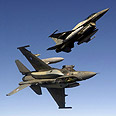
Back to surgical strikes
Op-ed: Israel resumes pinpoint eliminations of terrorists, the most effective anti-terror weapon
Since last Thursday there has been a change in the IDF’s modus operandi in the Gaza Strip. The political leadership granted the army and Shin Bet much more leeway and much more flexibility with regard to undertaking pinpoint eliminations of wanted terrorists: Whether they are ticking time bombs or hostile parties planning to perpetrate terror attacks at a later point.
Hamas sought a ceasefire, albeit nothing was put down in writing, and Israel rushed to establish the substance of this truce. One of its principles, as of today, is that if they fire rockets we will return to pinpoint eliminations according to a master list, along the same lines of the fugitive lists in the days of the Second Intifada.
Since Operation Cast Lead Israel has refrained from executing pinpoint eliminations against terror group leaders. Israel has also refrained from eliminations of terrorists in the field involved in planning attacks. At times we saw reports about a terror cell that left the Gaza Strip and was struck even before it crossed the border into Sinai, but for the most part pinpoint eliminations were reserved for ticking time bombs: that is, rocket launching cells eliminated before or after firing into Israel.
In other words, most terrorists could wander around the Gaza Strip with relative safety. Even when the infrastructure of the Popular Resistance Committees came together for executing the attack near Eilat – via Sinai – there was an opportunity to strike it. Some defense officials proposed doing just that. Yet senior officials decided not to execute such surgical strike due to political and operational reasons.
Prepare for escalation
When referring to the elimination of terror infrastructure the objective is not just to strike the men who directly execute the attack. Striking the planners and the men responsible for logistics can also affect execution of an attack. For example, there were cases where terror cells embarked on an attack, their infrastructure in the Gaza Strip was exposed and hit, and the cells returned without undertaking the planned attack.
The pinpoint elimination was and remains the most effective weapon in coping with terrorism and striking fear in its perpetrators. The IDF learned this in the Second Intifada, when it curbed the spread of terror networks by constantly cutting back the lists of wanted terrorists. In contrast to the Gaza Strip, in the West Bank it was also possible to make arrests. But in Gaza, cutting back the list can only be done by physically neutralizing the targets.
The defense minister hinted at the change in policy regarding surgical strikes at the beginning of the week in Ashkelon, when he mentioned cutting off terrorists’ heads. However, the pinpoint elimination is also a weapon that invites a quick reaction. Hamas and Islamic Jihad can accept a strike against the tunnels, store rooms or buildings. But a strike on their command structure, for example, forces them to react in an effort to deter Israel from continuing.
Hence, should Israel persist in the policy of eliminations now – which has since Thursday cut down five terrorists from the Popular Resistance Committees, five terrorists from Islamic Jihad and two Hamas terrorists – we can assume that the ceasefire declared by terrorist organizations will not last very long, and we shall find ourselves very quickly in the midst of a military operation.
- Follow Ynetnews on Facebook










